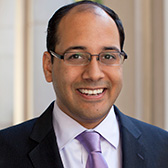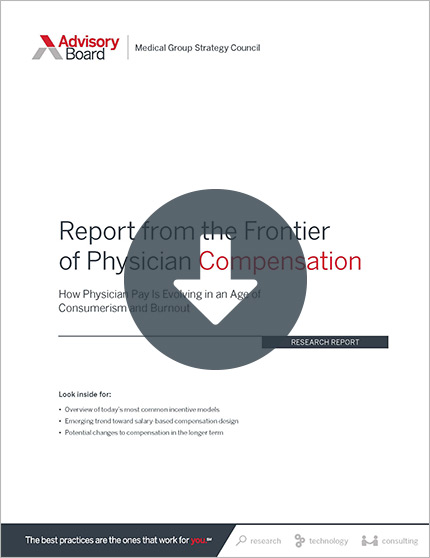Auto logout in seconds.
Continue LogoutRead Advisory Board's take: Why high salaries aren't the right way to recruit specialists
Hospitals are increasingly offering high salaries to specialists whose businesses are big referral generators, but the federal government is taking a closer eye on these practices—and has recently brought several suits that allege these arrangements count as kickbacks, Jordan Rau writes for Kaiser Health News.
The importance of referrals
Doctors generate a significant amount of revenue for hospitals through their referrals and the procedures and tests they order. For example, according to a survey released this year by Merritt Hawkins, an internal medicine doctor generates an average of $2.7 million in revenue for the hospital with which he or she is affiliated. A cardiovascular surgeon generates even more—an average of $3.7 million in revenue. These amounts are nearly nine to 10 times greater than their salaries.
As hospitals have sought ways to capture as much of this revenue as possible, some have begun buying physician practices and adding doctors to their payrolls, Rau writes.
"If you acquire some key physician practices, it really shifts their referrals to the mother ship," explained Martin Gaynor, a health policy professor at Carnegie Mellon University.
According to Avalere, as of January 2018, 44% of physicians were employed by hospitals and 31% of practices were owned by hospitals. Many of those purchases have occurred within the last few years—hospitals employed just 26% of physicians and owned just 14% of practices in July 2012, Avalere says.
A trend of lawsuits
However, these practices have come under newfound scrutiny from the Department of Justice (DOJ) for potential violations of the Stark Law and the federal anti-kickback statute. The Stark Law bars physicians from referring patients for services for which the physician has a financial interest, while the federal anti-kickback statute prohibits hospitals from paying doctors for their referrals.
Kate Stern, a lawyer in Atlanta who represents hospitals, said, "The law is very broad, and the exceptions are very narrow."
William Beaumont Hospital in Michigan last year paid $85 million to settle allegations from the federal government that it provided physicians with free or discounted offices and subsidized the cost of their assistants in exchange for referrals.
Similarly, a month later, Kalispell Regional Healthcare System paid a $24 million settlement in a lawsuit alleging the health system overcompensated 63 specialists in exchange for referrals, Rau writes. Both William Beaumont and Kalispell did not admit wrongdoing in their settlements.
Wheeling Hospital's hit by lawsuits
This spring, Wheeling Hospital in West Virginia was hit with similar allegations in a lawsuit filed by its former EVP Louis Longo and in a companion suit from DOJ.
DOJ's complaint alleges that once Ronald Violi took over as Wheeling's CEO in 2007, the hospital embarked on a physician hiring spree "to capture for the hospital those physicians' referrals and the resulting revenues, thereby increasing Wheeling Hospital's market share."
A 2008 internal memorandum cited in the lawsuit shows Wheeling's CFO saying that Ahmad Rahbar, a cardiovascular surgeon at the hospital, "is a man we need to keep happy" because the year before, "he generated over $11 million in revenues for us."
Chandra Swamy, an OB/GYN hired by Wheeling in 2009, was being paid $1.2 million by 2012, four times the national average for her peers, according to the lawsuit. Another internal memorandum quoted Wheeling's COO saying that the labor and delivery practice Swamy worked in was the biggest loser of money among the hospital's specialty divisions and that her salary made it "almost impossible for this practice to show a bottom line profit."
However, the memo also noted that Wheeling should "continue to absorb the practice loss" because it "would not want to endanger the significant downstream revenue that she produces" for the hospital, which was almost $4.6 million a year, the lawsuit said.
DOJ alleges that at least 36 physicians had employment contracts with Wheeling that were directly tied to the revenue they brought to the hospital. They assert that the hospital tracked the revenues physicians brought in and catered to those who were most lucrative.
From a financial perspective, these strategies appear to have worked well for Wheeling, Rau writes. According to the lawsuit, for the first five years Violi was CEO, Wheeling earned profits of almost $90 million, and Violi's management firm, R&V Associates, saw its annual compensation more than double from $1.5 million in 2007 to $3.5 million in 2018.
However, at the same time, the hospital was flagged as low-performing on key quality measures, Rau writes. According to Hospital Compare, patients with heart failure or pneumonia are more likely to die at Wheeling than at most hospitals, and in April, Medicare gave Wheeling a one-star overall rating for quality.
Wheeling is contesting the lawsuits, arguing that the salaries it provided to physicians were not kickbacks, but rather the only way the hospital could attract the specialists it needs to provide specialized care to the residents of its community who otherwise would have had to go to other cities for services like labor and delivery.
Gregg Warren, a spokesperson for the hospital, in a statement said, "We are confident that, if this case goes to a trial, there will be no evidence of wrongdoing—only proof that Wheeling Hospital offers the Northern Panhandle Community access to superior care, world class physicians and services" (Rau, Kaiser Health News, 5/31).
Advisory Board's take

Hamza Hasan, Practice Manager, Medical Group Strategy Council
Without fully understanding the specific details of Wheeling Hospital's case, I can say that I recognize the challenges rural hospitals face when trying to attract and recruit specialists to their facilities. According to a Merritt Hawkins survey, 93% of final-year residents say they would prefer to practice in communities of 50,000 people or more, compared to just 3% looking or communities of 25,000 or less—clearly a barrier to rural recruitment. That being said, I would urge hospitals to think beyond simply increasing specialist compensation as their sole strategy for attracting the right talent. We've seen that many hospitals make the mistake of prioritizing compensation over other factors to attract doctors, and this strategy often fails to keep physicians in the long-term.
“This strategy often fails to keep physicians in the long-term.”
Our research shows that recruitment battles today are not being won by the size of the compensation package alone. Of course, hospitals must provide market-competitive compensation as a baseline, but given today's limits on how high pay can realistically go and with levers such as signing bonuses now common, compensation is not a true differentiator. We spoke to one health system which, despite previously believing that compensation was the most important factor in recruitment, actually found that only one candidate out of many had actually declined an offer due to low pay. Furthermore, any physician who chooses a job solely because of the pay package may often prove to be a poor cultural fit in the long-run.
Of course, prioritizing other factors for recruitment is not easy. This is particularly true in rural areas which many young physicians see as offering a less attractive lifestyle. To overcome this barrier, our research has found that the most experienced rural recruiters focus on cultural and mission-driven factors when sourcing candidates. Consider strategies that, instead of encouraging young physicians to come from elsewhere to rural areas because of high pay, grow the pipeline of physicians who truly want to work in rural areas. For instance, many leading organizations focus on growing the number of rural youth who chose a medical career, target physicians who want to help the underserved, and tout the benefits of a smaller, more intimate practice environment.
To learn more about these rural-specific strategies, and other strategies that health systems in any environment can use to attract candidates without sky-high salaries, download our research report on Winning the War for Physician Talent.
Don't miss out on the latest Advisory Board insights
Create your free account to access 1 resource, including the latest research and webinars.
Want access without creating an account?
You have 1 free members-only resource remaining this month.
1 free members-only resources remaining
1 free members-only resources remaining
You've reached your limit of free insights
Become a member to access all of Advisory Board's resources, events, and experts
Never miss out on the latest innovative health care content tailored to you.
Benefits include:
You've reached your limit of free insights
Become a member to access all of Advisory Board's resources, events, and experts
Never miss out on the latest innovative health care content tailored to you.
Benefits include:
This content is available through your Curated Research partnership with Advisory Board. Click on ‘view this resource’ to read the full piece
Email ask@advisory.com to learn more
Click on ‘Become a Member’ to learn about the benefits of a Full-Access partnership with Advisory Board
Never miss out on the latest innovative health care content tailored to you.
Benefits Include:
This is for members only. Learn more.
Click on ‘Become a Member’ to learn about the benefits of a Full-Access partnership with Advisory Board
Never miss out on the latest innovative health care content tailored to you.


